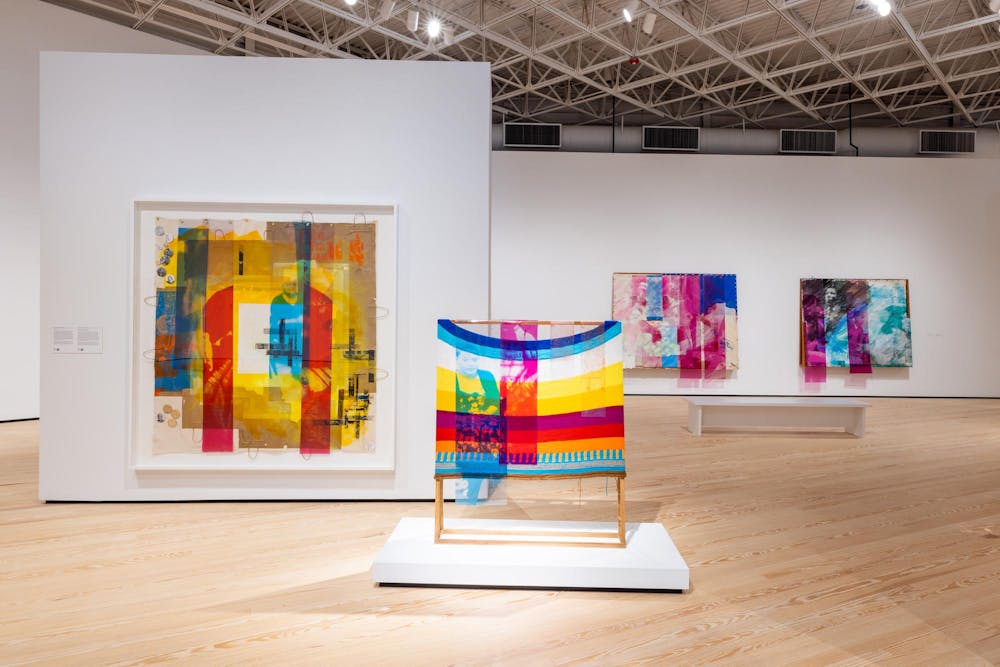Review: “Tomashi Jackson: Across the Universe” uses color to challenge race at Contemporary Arts Museum Houston

The installation view of “Tomashi Jackson: Across the Universe” at the Contemporary Arts Museum Houston.
Courtesy Contemporary Arts Museum Houston
Score: ★★★★
Courtesy Image (Installation view of Tomashi Jackson: Across the Universe at Contemporary Arts Museum Houston (CAMH). Image courtesy Contemporary Arts Museum Houston. Photo: Alex Barber.)
Color, the artist and educator Josef Albers theorized, is relative. A red square flanked by yellow appears orange; surrounded by blue, it looks purple. Rather than being absolute, color behaves in constant flux. In “Tomashi Jackson: Across the Universe,” the titular multimedia artist extends this principle to racial categorization, suggesting that race, too, operates through relational mechanisms.
This is not color as metaphor for race, but color charged as co-conspirator in the formation of racial categories itself: the way a hue shifts in relation to its neighbor reflects how policies and practices shift the social meaning of bodies and neighborhoods.
Jackson’s paintings incorporate reproductions of legal documents and historical photographs, treating these archival materials as compositional elements that activate and are activated by saturated pigment.
The exhibition’s printmaking and collage components are Jackson’s most potent theoretical intervention. Translating archival photographs into halftone line images, the artist creates documentary abstractions that allow historical evidence to function as mark-making.
In “Heiresses (The Central Park Plan),” Jackson layers portraits across time using strips of blues, yellows and magentas. Harriet Tubman anchors the bottom left, while Mary Joseph Lyons — a Black abolitionist whose family owned multiple properties in the demolished Seneca Village — occupies the upper left. Between them, images of contemporary women of color experiencing property seizures throughout New York create a visual dialogue among interconnected histories.
Jackson’s visual strategy — informed by Thurgood Marshall’s pioneering use of photography in civil rights legal strategy — enables her to draw with the apparatus of legal and historical documentation. “Time and Space (1948 End of Voter Registration Line)(1965 LBJ Signs the Voting Rights Act)” incorporates magenta vinyl reproductions of President Lyndon B. Johnson signing the Voting Rights Act of 1965 and layers it over blue halftone lines depicting Black people waiting in a voter registration line. Her research-driven practice takes the supposedly objective — legal transcripts, photography and color theory — and reveals its subjective underpinnings.
This formal restlessness is also ethical. The optical effect Albers called “vibrating boundaries” — the uneasy, almost aggressive sensation produced by juxtaposing complementary colors — serves as an analogue for racialized encounter. Where segregation attempted to fix bodies to places, Jackson’s seams of layered color refuse solidity. In “Emerald City (Get ’Em! Get the Last Ones!),” color buzzes at edges. It leaks and refracts. The effect is a conceptual insistence that categories are contingent and politically produced.
The viewer is asked to look long enough for images to appear and change. Rather than simply reproducing historical documents to authenticate her arguments, she subjects the archive to processes of visual translation that render the imagery simultaneously more and less legible.
Up close, the photographs in the multimedia painting “Across the Universe (Frontlash)” — depicting LBJ’s 1964 speech on his vision for the Great Society at the University of Michigan and Nina Simone’s 1969 performance at Morehouse College — dissolve into abstract patterning; from a distance, it coheres into recognizable documentation. This perceptual instability insists that no single viewing position contains the complete truth of any documented encounter.
Jackson’s colorful awnings punctuate the exhibition. Inspired by commercial vernacular design, these metal structures evoke the ambience of urban driving — passing storefronts, barbershops and botanicas. In one such piece, “Interstate Love Song (Friends of Clayton County Transit) (Pitts Road Station Opposition),” Jackson silkscreens archival images across vermilion and magenta strips, juxtaposing transit advocates from 2014 campaigning for expanded bus service in underfunded areas with white protesters from 1981 opposing public transportation development.
Awnings promise shelter, but for whom? Jackson uses the awnings’ promise of protection to highlight how public infrastructure — which shapes who belongs where, who moves freely and who waits in the rain — remains unevenly distributed.
Performance and intimacy are threaded throughout the show. Jackson’s “moving paintings” transform the museum’s black box theater into an intimate screening room where she performs as Tommy Tonight, a drag king persona lip-syncing to her mother’s musical archive.
More confrontational are Jackson’s video collages projected onto the museum’s white cube. “Vibrating Boundaries (Law of the Land) (Self Portrait as Tatyana, Dajerria, & Sandra)” recreates encounters involving Tatyana Rhodes, Dajerria Becton, Sandra Bland and other Black women in Texas whose confrontations with state power became national flashpoints. Taking its title from Albers’ theory of color relativity, Jackson applies the optical principle to social dynamics: the perceived value of life changes depending on its surroundings in public space. Color is Jackson’s method for examining how power shapes perception, and how that perception can determine who lives and who dies.
If the exhibition’s chief strength is its ability to translate historical material into perceptual experience, its limitation is one of audience calibration. The work rewards sustained attention and a little historical literacy; those expecting immediate narratives may find the formal opacity daunting. Yet that difficulty is also the point: Jackson asks us to unlearn the immediacy of visual certainty, to attend to the ways adjacency alters meaning.
“Tomashi Jackson: Across the Universe” asks viewers to reconsider not just what they see but how they see — to recognize perception itself as always already a political act, always already implicated in systems of power often misunderstood as natural phenomena. Color, in Jackson’s experiments, becomes a potential cure for the optical diseases that racial segregation, in its attempt to categorize and restrain color categories, has trained into American vision.
Jackson’s oeuvre insists that learning to look more carefully might be prerequisite to looking more justly. It commands: see us for what we are by learning to see differently, to see relationally, to see color as a verb rather than a noun.
“Tomashi Jackson: Across the Universe” is on view through March 29, 2026 at Contemporary Arts Museum Houston.
Color, the artist and educator Josef Albers theorized, is relative. A red square flanked by yellow appears orange; surrounded by blue, it looks purple. Rather than being absolute, color behaves in constant flux. In “Tomashi Jackson: Across the Universe,” the titular multimedia artist extends this principle to racial categorization, suggesting that race, too, operates through relational mechanisms.
This is not color as metaphor for race, but color charged as co-conspirator in the formation of racial categories itself: the way a hue shifts in relation to its neighbor reflects how policies and practices shift the social meaning of bodies and neighborhoods. Jackson’s paintings incorporate reproductions of legal documents and historical photographs, treating these archival materials as compositional elements that activate and are activated by saturated pigment.
The exhibition’s printmaking and collage components are Jackson’s most potent theoretical intervention. Translating archival photographs into halftone line images, the artist creates documentary abstractions that allow historical evidence to function as mark-making. In “Heiresses (The Central Park Plan),” Jackson layers portraits across time using strips of blues, yellows and magentas. Harriet Tubman anchors the bottom left, while Mary Joseph Lyons — a Black abolitionist whose family owned multiple properties in the demolished Seneca Village — occupies the upper left. Between them, images of contemporary women of color experiencing property seizures throughout New York create a visual dialogue between interconnected histories.
Jackson’s visual strategy — informed by Thurgood Marshall's pioneering use of photography in civil rights legal strategy — enables her to draw with the apparatus of legal and historical documentation. “Time and Space (1948 End of Voter Registration Line) (1965 LBJ Signs the Voting Rights Act)” incorporates magenta vinyl reproductions of President Lyndon B. Johnson signing the Voting Rights Act of 1965 and layers it over blue halftone lines depicting Black people waiting in a voter registration line. Her research-driven practice takes the supposedly objective — legal transcripts, photography and color theory — and reveals its subjective underpinnings.
This formal restlessness is also ethical. The optical effect Albers called “vibrating boundaries” — the uneasy, almost aggressive sensation produced by juxtaposing complementary colors — serves as an analogue for racialized encounter. Where segregation attempted to fix bodies to places, Jackson’s seams of layered color refuse solidity. In "Emerald City (Get ‘Em! Get the Last Ones!)," color buzzes at edges. It leaks and refracts. The effect is a conceptual insistence that categories are contingent and politically produced.
The viewer is asked to look long enough for images to appear and to change as they do so. Rather than simply reproducing historical documents to authenticate her arguments, she subjects the archive to processes of visual translation that render the imagery simultaneously more and less legible. Up close, the photographs in the multimedia painting “Across the Universe (Frontlash)” — depicting LBJ’s 1964 speech on his vision for the “Great Society” at the University of Michigan and Nina Simone's 1969 performance at Morehouse College — dissolve into abstract patterning; from a distance, it coheres into recognizable documentation. This perceptual instability insists that no single viewing position contains the complete truth of any documented encounter.
Jackson’s colorful awnings punctuate the exhibition. Inspired by commercial vernacular design, these metal structures evoke the ambience of urban driving — passing storefronts, barbershops, botanicas. In one such piece, "Interstate Love Song (Friends of Clayton County Transit) (Pitts Road Station Opposition)," Jackson silkscreens archival images across vermilion and magenta strips, juxtaposing transit advocates from 2014 campaigning for expanded bus service in underfunded areas with white protesters from 1981 opposing public transportation development. Awnings promise shelter, but for whom? Jackson uses the awnings’ promise of protection to highlight how public infrastructure — which shapes who belongs where, who moves freely and who waits in the rain — remains unevenly distributed.
Performance and intimacy are threaded throughout the show. Jackson’s “moving paintings” transform the museum’s black box theater into an intimate screening room where she performs as Tommy Tonight, a drag king persona lip-syncing to her mother’s musical archive.
More confrontational are Jackson’s video collages projected onto the museum’s white cube. "Vibrating Boundaries (Law of the Land) (Self Portrait as Tatyana, Dajerria, & Sandra)" recreates encounters involving Tatyana Rhodes, Dajerria Becton, Sandra Bland and other Black women in Texas whose confrontations with state power became national flashpoints. Taking its title from Albers’ theory of color relativity, Jackson applies the optical principle to social dynamics: the perceived “value” of life changes depending on its surroundings in public space. Color is Jackson’s method for examining how power shapes perception, and how that perception can determine who lives and who dies.
If the exhibition’s chief strength is its ability to translate historical material into perceptual experience, its limitation is one of audience calibration. The work rewards sustained attention and a little historical literacy; those expecting immediate narratives may find the formal opacity daunting. Yet that difficulty is also the point: Jackson asks us to unlearn the immediacy of visual certainty, to attend to the ways adjacency alters meaning.
“Tomashi Jackson: Across the Universe” asks viewers to reconsider not just what they see but how they see — to recognize perception itself as always already a political act, always already implicated in systems of power often misunderstood as natural phenomena. Color, in Jackson’s experiments, becomes a potential cure for the optical diseases that racial segregation, in its attempt to categorize and restrain color categories, has trained into American vision.
Jackson’s oeuvre insists that learning to look more carefully might be prerequisite to looking more justly. It commands: see us for what we are by learning to see differently, to see relationally, to see color as a verb rather than a noun.
“Tomashi Jackson: Across the Universe” is on view through March 29, 2026 at Contemporary Arts Museum Houston.
More from The Rice Thresher

Former Rice basketball player Chadd Alexander talks Broadway show ‘Harry Potter and the Cursed Child’
Underneath Chadd Alexander’s Broadway costume, there’s ankle tape and wrist braces — same protective gear he wore as a walk-on basketball player at Rice, though now he’s performing eight shows a week in the ensemble of “Harry Potter and the Cursed Child” instead of running conditioning drills in Tudor Fieldhouse.

Students see expanded merch and restaurant discounts
The Campus Bookstore will now offer a 30% discount to any one apparel item on the first Friday of every month, a change from the previous 10% discount on a designated “spirit item” introduced last April, according to an Instagram post by the Student Association.
“Love Island” Season 7: A Messy, Magnetic Reality Show
It was my first time watching “Love Island,” and I get it now. There's a cycle to this show: you swear you won't get sucked in, you dismiss it as background noise, and then, one week later, you're canceling plans just to hear a group of twenty-somethings debate the meaning of the word "exploring." The truth is, “Love Island” has plenty of flaws. It’s too long, too produced and too ridiculous, but I'll be the first to admit it: I'm already planning to watch next season.


Please note All comments are eligible for publication by The Rice Thresher.